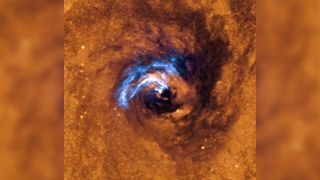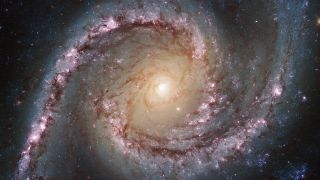Supermassive black holes can be surprisingly delicate eaters, astronomers find
The supermassive black hole's eating habits were captured in a striking image.

How do you feed an all-consuming, cosmic glutton that is a black hole? With long, wispy filaments of dust, according to researchers who have stared into the very belly of the beast.
Scientists imaged this particular picnic at the heart of a galaxy called NGC 1566, using the Hubble Space Telescope and the European Southern Observatory's (ESO) Very Large Telescope (VLT) and the Atacama Large Millimeter Array (ALMA) in Chile.
"This group of telescopes has given us a completely new perspective of a supermassive black hole, thanks to the imaging at high angular resolution and the panoramic visualization of its surroundings, because it lets us follow the disappearance of the dust filaments as they fall into the black hole," Almudena Prieto, lead author of the new study and an astronomer at Instituto de Astrofísica de Canarias (IAC) in the Canary Islands, said in a statement.
Related: Where do black holes lead?
NGC 1566 is located approximately 40 million light-years from Earth and boasts a powerful supermassive black hole at its center. Scientists combined images captured by the Hubble Space Telescope, VLT and ALMA, to capture a direct snapshot of this black hole snacking.
Before its consumption, dusty material accelerates towards the black hole at speeds of up to 50 miles (80 km) per second, according to the study. As it approaches, the dust filaments separate out into long streaks whirling around the center of the black hole. Their swirling path draws them ever closer to the devouring nucleus before eventually being swallowed up.
The black hole appears — at first — to have quite the appetite as it slurps up dust filaments that are reported to be several hundred light-years long and less than ten light-years wide.
Get the Space.com Newsletter
Breaking space news, the latest updates on rocket launches, skywatching events and more!
These lengthy meals, however, are not very substantial. "A black hole needs not much to get active. In this one, we calculate[d] the rate of infalling material to be much less than 1/100 the mass of the sun per year," Prieto told Space.com in an email. To put it in context, this equates to approximately the mass of 3,300 Earths annually.
This is the first time such eating habits have been imaged so directly, according to Prieto. "We are seeing this feeding in other BHs [black holes] but such obvious evidence is astonishing," Prieto wrote.

The study has not only divulged the eating habits of the black hole at the center of NGC 1566 but has also revealed that the swirling dust filaments could cause the darkening of the centers of many galaxies when their black holes at the core are active.
Astronomers hope that these findings will help them understand more about the lives of supermassive black holes, from their awakening to eventually becoming the most powerful objects in the universe.
The research is described in a new study published July 8 in the Monthly Notices of the Royal Astronomical Society (MNRAS).
You can follow Daisy Dobrijevic on Twitter at @DaisyDobrijevic. Follow us on Twitter @Spacedotcom and on Facebook.
Join our Space Forums to keep talking space on the latest missions, night sky and more! And if you have a news tip, correction or comment, let us know at: community@space.com.

Daisy Dobrijevic joined Space.com in February 2022 having previously worked for our sister publication All About Space magazine as a staff writer. Before joining us, Daisy completed an editorial internship with the BBC Sky at Night Magazine and worked at the National Space Centre in Leicester, U.K., where she enjoyed communicating space science to the public. In 2021, Daisy completed a PhD in plant physiology and also holds a Master's in Environmental Science, she is currently based in Nottingham, U.K. Daisy is passionate about all things space, with a penchant for solar activity and space weather. She has a strong interest in astrotourism and loves nothing more than a good northern lights chase!
